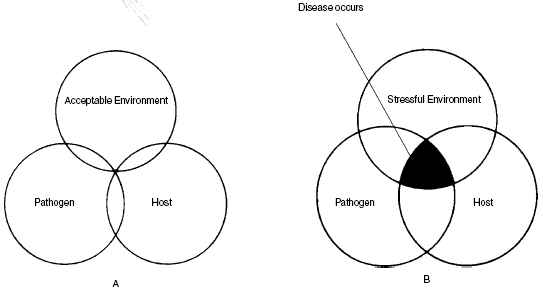Stress may result from a variety of conditions, including overcrowding, handling stress, poor water quality, inadequate nutrition and weather-related environmental stress. These forms of stress may kill fish outright, in which case they can be considered non-infectious diseases. More often, however, they do not kill fish outright but lead to outbreaks of infectious diseases. Ironically, a common cause of stress is chemical toxicity from disease or weed control efforts. In summary, three factors are involved in fish disease outbreaks: infectious pathogens (viruses, bacteria, fungi or protozoan parasites) must be present and capable of attacking the fish, the fish must already be in a susceptible state, and certain environmental conditions, such as specific temperatures or poor water quality, must be present. (see Figure 21)

Figure 21. Disease-Host-Environmental Stress Diagram
As mentioned, many fish disease-causing organisms are usually present in ponds, and little can be done to eliminate them or prevent them from recurring. These organisms alone, however, are usually not enough to cause disease problems. For this reason, disease problems will usually reoccur in fish ponds unless the conditions which caused the initial fish stress can be identified and eliminated. Three main practices can minimize the possibility of disease outbreaks. These are maintenance of good water quality, proper nutrition and elimination of contact with wild fish whenever possible. A sound fertilization program can contribute to the first two objectives. The third can be achieved through proper pond design and water management, as well as prevention of fish introductions outside of the established stocking plan.
Common water quality stressors are low dissolved oxygen and/or a buildup of toxic nitrogenous compounds, especially ammonia and nitrite. Dissolved oxygen problems are most common in the early spring and the mid-to-late summer. Nitrogenous compounds are more of a problem in cold water during the winter.
What to Look For
Fish should be observed every day, if possible, or as often as practical. The following signs should be noted immediately: reduced feeding, scratching or rubbing against submerged objects and/or the pond bottom, piping or gasping at the water surface, convulsions or erratic motion, abnormal swimming (spinning or spiraling), blisters or sores, swollen bellies, listlessness, bulging eyes, bloody or bruised fins, discoloration or erosion of fins and skin, excessive mucus, puffy or bleeding gills and growths or spots on the body surface.
What to Do
Rates of mortality should be carefully recorded and monitored over time to help determine the cause of the problem. Your county agent can assist in obtaining a disease diagnosis and treatment recommendation if disease problems develop. The sooner a diagnosis is obtained, the sooner corrective measures can eliminate the cause of the outbreak. Although direct treatment of certain diseases may be possible in recreational ponds, these options are limited to situations where fish such as catfish or bream can be fed medicated pellets or where external parasites can be treated without further stress on the fish population. Do not attempt disease treatment without a professional diagnosis and treatment recommendation. Indiscriminate use of chemicals or medications almost always wastes money, time and fish.
Internal Parasites
Many ponds produce fish with worms or cysts in the flesh. Perhaps the most common of these organisms is the yellow grub, although the white, black and eye grubs are also widely found in pond fish. All these parasites have similar life cycles, based on intermediate hosts such as snails and birds. Although these grubs are not harmful to humans eating the fish, they are unappetizing and result in physiologic stress to fish.
To control these parasites, their life cycle must be broken. Perhaps the easiest way to achieve this with the yellow grub is to eliminate snails, which serve as intermediate hosts. Pond owners should avoid introducing snails and infected fish during stocking. If snails become established, vegetation control will limit their available food and cover. Perhaps the best approach to snail control is stocking of redear sunfish, which will further reduce snail populations. If these measures fail to control the problem within an acceptable period, it may be necessary to drain and dry the pond to eradicate these parasites.

